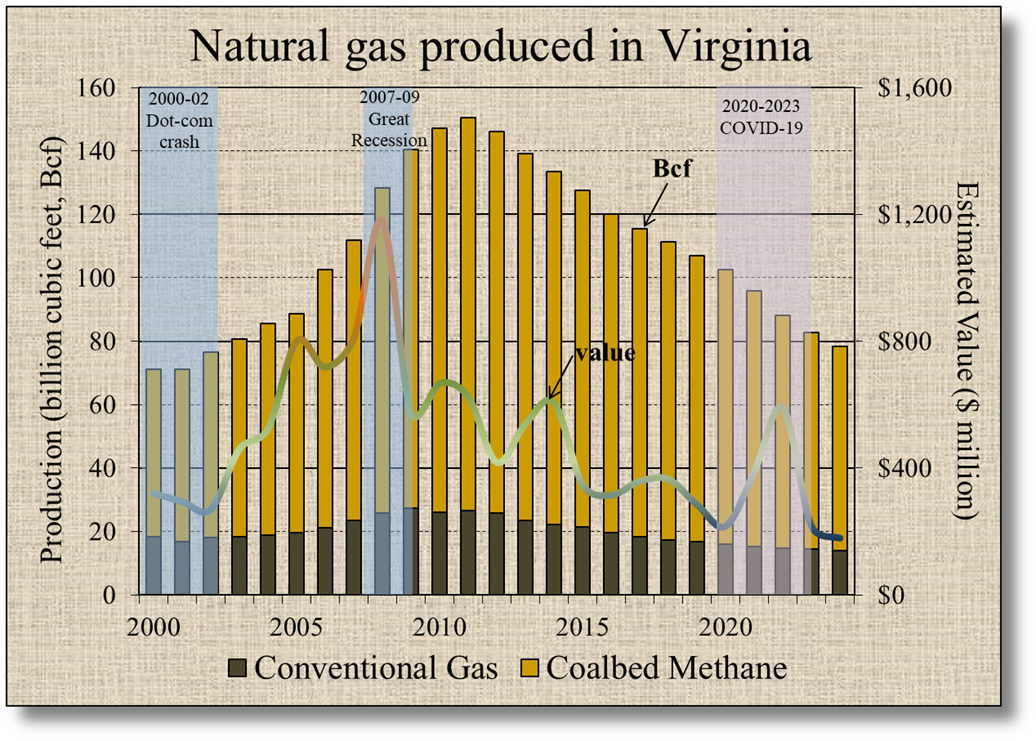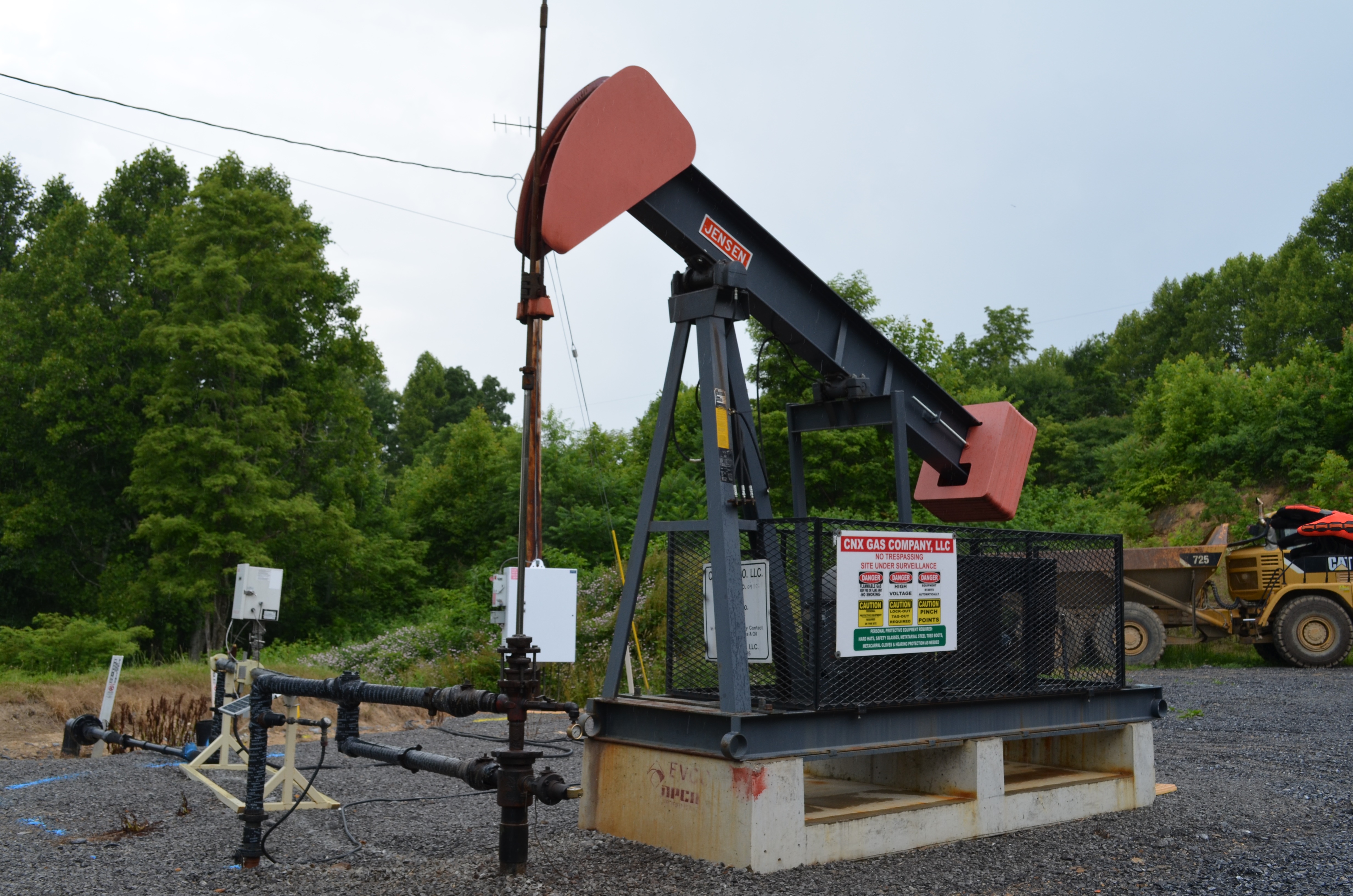Virginia's gas and oil industry reported the production of 78.6 billion cubic feet (Bcf) of natural gas in 20241, down about 5 percent from the production reported in 2023. Coalbed methane accounted for about 79 percent of the total. The estimated value of natural gas produced in 2024 is $178.3 million.

Natural gas production and value in Virginia
1Gas production is reported in annual reports to Virginia Energy and may differ from the production figures reported by the U.S. Energy Information Administration (EIA). The annual value of produced gas is calculated using the total production reported to Virginia Energy and the annual average Henry Hub (NYMEX) unit price reported by the U.S. Energy Information Administration (EIA). For 2024, the value was $2.19 per million Btu ($2.27 per thousand cubic feet, Mcf).
Natural gas is a mixture of hydrocarbon compounds, mainly methane (CH4), ethane (C2H6), and propane (C3H8), usually containing small amounts of impurities such as carbon dioxide (CO2), nitrogen (N2), and water vapor. Natural gas is a fossil fuel energy resource that serves residential and commercial needs for space heating, water heating and cooking. It also fuels natural gas-powered vehicles and electric power generating plants, and is used as a chemical feedstock in industrial processes.

Coal Bed Methane well, Buchanan County
In Virginia, natural gas is commercially produced from two types of geologic reservoirs. Gas that originally forms in deeply buried organic source rocks and subsequently migrates and is trapped in porous or fractured rock reservoirs is known as conventional gas. Conventional gas reservoirs occur in Devonian-age (354 to 417 million years old) shales and Mississippian-age (323 to 354 million years old) limestones and sandstones in the Appalachian Plateaus Province. The other type of reservoir is known as unconventional or "continuous", and includes gas that forms in coal beds, i.e. coal bed methane. Significant coal bed methane resources occur in the Pennsylvanian-age (290 to 323 million years old) Norton, Lee (New River), and Pocahontas Formations, also in the Appalachian Plateaus Province.

Natural gas production locations
Year of first production in Virginia: 1931
Location of first production: Scott County
Number of gas wells (permitted) in Virginia: 8,261
Counties in Virginia where gas is currently produced: Buchanan, Dickenson, Russell, Lee, Scott, Tazewell, Wise
Number of companies: 17
Quantity produced in 2024: 78.6 Bcf
Estimated market value in 2024: $178.3 million
Total cumulative production (since 1950): about 3,371 Bcf
Selected References:
Averitt, P., 1941, The Early Grove Gas Field, Scott and Washington Counties, Virginia, Virginia Division of Geology and Mineral Resources Bulletin 56, 50 p., 3 pls., 4 figs., 5 tables.
Gilmer, Amy K., Enomoto, Catherine B., Lovett, James A., and Spears, David B., 2005, Mineral and Fossil Fuel Production in Virginia (1999-2003): Virginia Division of Mineral Resource Open File Report 05-04, 77 p.
Jacobeen, F. H., Jr., 1992, Oil and Gas Well Analyses of Hydrocarbon Potential of Buchanan, Dickenson and Wise Counties, Virginia; Virginia Division of Geology and Mineral Resources Open-File Report 92-2, 17 p., 3 figs., 5 tables, 26 plates.
LeVan, D. C., and Rader, E. K., 1983, Relationship of Stratigraphy to Occurrences of Oil and Gas in Western Virginia; Virginia Division of Geology and Mineral Resources Publication 43, one sheet.
Milici, Robert C., and Upchurch, Michael L., 1991, Virginia Division of Geology and Mineral Resources Brochure Oil and Gas in Virginia revised 2007.
Milici, R.C., 2016, Oil and gas, in Bailey, C.M., Sherwood, W.C., Eaton, L.S., and Powars, D.S., (eds.), The Geology of Virginia: Virginia Museum of Natural History Special Publication 18, p. 463-474.
Additional Resources:
Resource Assessment and Exploration Potential of the Devonian Gas Play in Virginia
U.S. Energy Information Administration
Virginia Center for Coal and Energy Research at Virginia Tech
